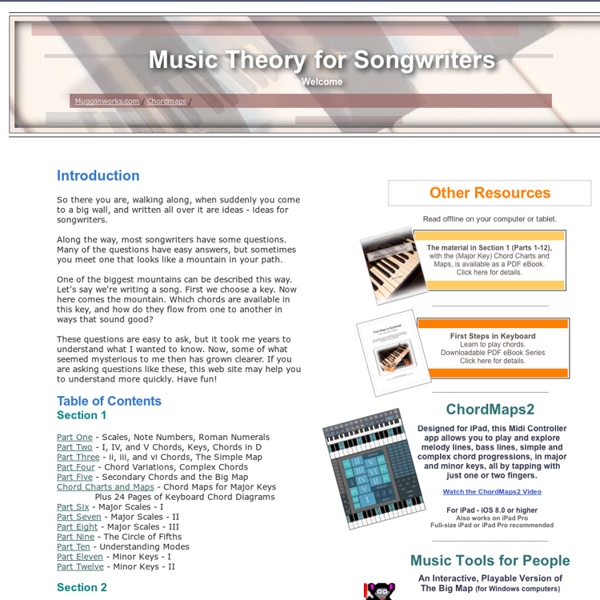



Speed exercises for guitar I've used these myself, and have found them to be quite amazing, both in strengthening your fingers and in training your mind. If you look at the patterns, they represent the three patterns that most scales are composed of: Half step -whole step, whole step - half step, whole step - whole step. If you get fast enough at playing it, people will worship you. If male, your penis will be enlarged, if female, your breasts will grow a size. Speed is everything in guitar. Okay, enough with the testosterone rant.
Outline of basic music theory - www.oscarvandillen.com Professional music theory: an outline of basic music theory. Preface and Chapter 1 of the Outline of basic music theory – by Oscar van Dillen ©2011-2014 The beginner’s learning book can be found at Basic elements of music theory. Overview of chapters: Diariamente Lista Zen - 12 Sitios Web de utilidad para mejorar su escritura by Johnny Webber 1. Words-to-Use.com – A different kind of thesaurus.
Chord Construction Now here's what you do to make your very own chords. It is very simple once you have the scale chart (below). You take the formula chart (below) find the chord you're looking for (major, minor, minor 7, diminished, etc.). Now look at the roman numerals that are next to each chord. those are the components of the chord (They tell you which notes to use). Then you go to the major scale chart (below) and find the scale of the chord you want. For example, if you want a G Major chord go to the G scale in the scale chart. Cool Jazz Chord Progressions for Guitar Are you looking for some cool jazz chord progressions for the guitar? Sometimes guitar players who are coming from a blues, folk or rock background think that jazz music is a cacophonous assortment of random notes. While such an argument could be made about some forms of free jazz, many jazz songs are based around standard progressions that aren't much different than the progressions found in other forms of music. Read on to learn more about some really cool jazz chord progressions for guitar. Get a Chord Chart
Harmony Explained: Progress Towards A Scientific Theory of Music The Major Scale, The Standard Chord Dictionary, and The Difference of Feeling Between The Major and Minor Triads Explained from the First Principles of Physics and Computation; The Theory of Helmholtz Shown To Be Incomplete and The Theory of Terhardt and Some Others Considered Daniel Shawcross Wilkerson Begun 23 September 2006; this version 19 February 2012. Abstract and Introduction Most music theory books are like medieval medical textbooks: they contain unjustified superstition, non-reasoning, and funny symbols glorified by Latin phrases. How does music, in particular harmony, actually work, presented as a real, scientific theory of music?
Los cuestionarios para Perfiles de personajes de escritura - Escritura Creativa Ayuda Enter your e-mail to get the e-book for FREE. We'll also keep you informed about interesting website news. "I have searched the web and used different worksheets, but none have come close to your worksheets and descriptions of (what to do and what not to do). Both courses I have taken have with Creative Writing Now have been amazing.
How To Improve As A Guitarist Music is a part of everyone’s lives. When one thinks of music, one normally thinks of symphonies, pianos, rock bands and quite naturally guitarists. Everyone wants to be the next Jimi Hendrix and Eddie Van Halen, but most people do not have the talent or the time to tune up their guitaring talents. Interactive Circle of Fifths 1.) Click on a key name (C,D, Ab, G# etc…) to spin the circle until that key is at the top. The name in the red oval should always be the key you are interested in so make sure it is at the top. Tinta - Citas sobre la escritura de los escritores presentados por el Grupo Fontayne Writing "I put a piece of paper under my pillow, and when I could not sleep I wrote in the dark." Henry David Thoreau "Writing is an adventure." Winston Churchill "Know something, sugar?
The Ultimate Road Trip Playlist — 50 Best Road Trip Songs No road trip is complete without a playlist of songs that capture the spirit of traveling on the open road. So we’ve compiled a list of the 50 best road trip songs . In order to make this be-all end-all totally definitive list that all other lists look up to, the songs had to meet the following criteria: a.) encompass the excitement and freedom of road tripping b.) make the time pass faster